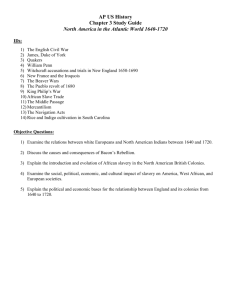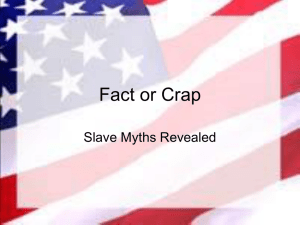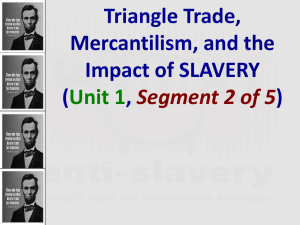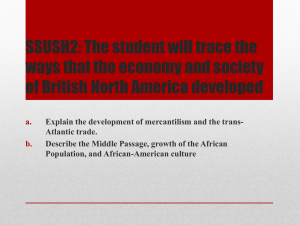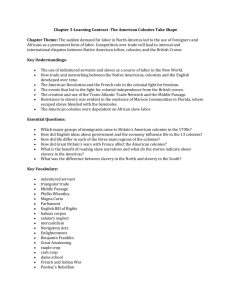Triangle Trade, Mercantilism, and the Impact of SLAVERY (Unit 1
advertisement
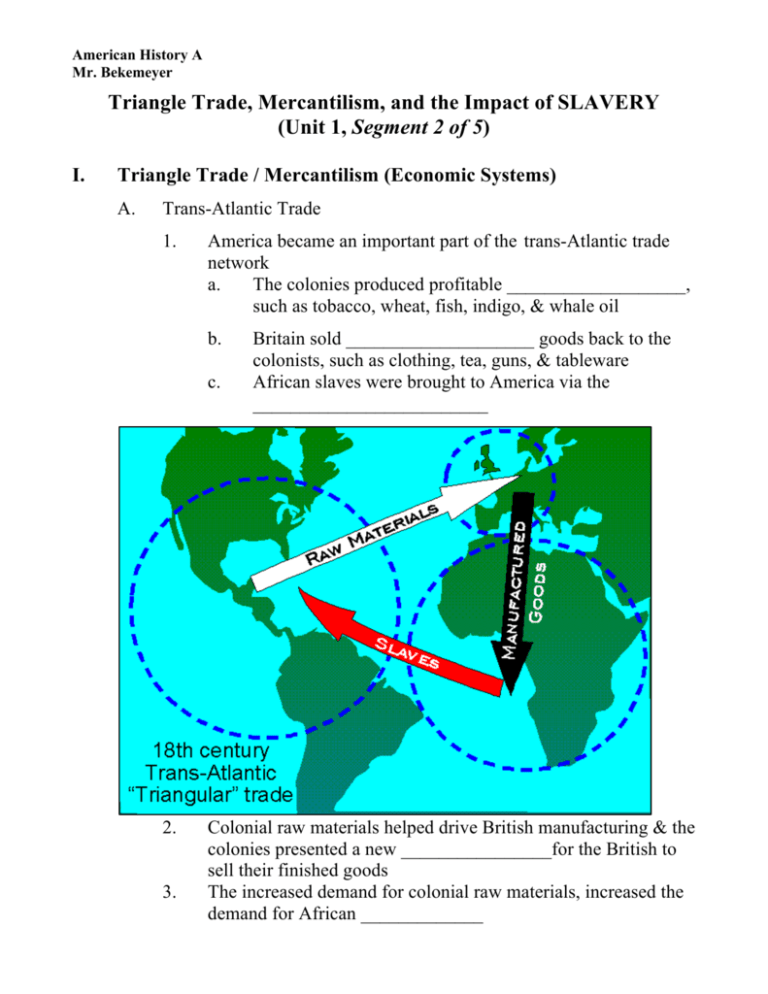
American History A Mr. Bekemeyer Triangle Trade, Mercantilism, and the Impact of SLAVERY (Unit 1, Segment 2 of 5) I. Triangle Trade / Mercantilism (Economic Systems) A. Trans-Atlantic Trade 1. America became an important part of the trans-Atlantic trade network a. The colonies produced profitable ___________________, such as tobacco, wheat, fish, indigo, & whale oil b. c. 2. 3. Britain sold ____________________ goods back to the colonists, such as clothing, tea, guns, & tableware African slaves were brought to America via the _________________________ Colonial raw materials helped drive British manufacturing & the colonies presented a new ________________for the British to sell their finished goods The increased demand for colonial raw materials, increased the demand for African _____________ 4. This pattern of trade between Europe, the colonies, and Africa became known as the _______________________ 5. When the British colonies were first founded, there were few restrictions on who the colonists could trade with B. Mercantilism 1. By the 1650s, the British gov’t began to embrace the economic policy of ________________________________: a. b. The colonies exist to generate wealth for the ___________________________ Promoted a balance of trade (more exports than imports) c. Meant that colonial trade must be regulated & controlled II. Slavery Life in the Americas A. Slavery in the "Southern" Colonies 1. Slavery in the Southern colonies was far more common than in the Northern colonies: a. Cash-crop agriculture, like tobacco & rice, required workers b. By 1660, fewer indentured servants were coming to America c. 80-90% of Southern slaves were ____________________, most on plantations d. Slave culture in the South: (i) Slaves came from a variety of places in West Africa & had a variety of languages & cultures (ii) ___________________ & dance were used to maintain their African culture (iii) ________________ were common, but marriage was not recognized (iv) e. Slave religion often blended African rituals with Christianity Slavery led to resistance: (i) _______________________ slaves were common (ii) Sabotaging of field tools & intentionally slowing down the work were common techniques of slave resistance B. Impact of the Slave Trade 1. Approx. 1500-1800 (?) a. ___________________ outlawed in Denmark (1803), G.B. (1807), U.S. (1808), France (1814), Netherlands (1817), Spain (1845) Slavery itself??? 2. The Numbers: a. 15th-16th Centuries – 2,000 Africans exported per year b. 17th Century – 20,000 “…” c. 18th Century – 55,000 “…” d. 1780s – slave exports averaged _______________ per year, some times exceeding 100,00 per year e. TOTAL NUMBER Exported: (10 - 12 million) (2 + million died during transport--the middle passage) 3. 4. What impact did slave trade have upon African society? a. Not all of Africa was affected equally by the trade b. Role of Geography: Kingdoms of Rwanda and Burundi were ________ because they were _______________ kingdoms c. Some African societies benefited economically and flourished (EX.) Oyo, Asante, and the Dahomey built powerful states with newly obtained firearms Losses from the Slave trade: a. Individual societies drastically impacted (Angola and Senegal—near slave ports) b. _________________________ of gender ratios (2/3rds of slaves exported were male) Caused political turmoil among African societies c.

